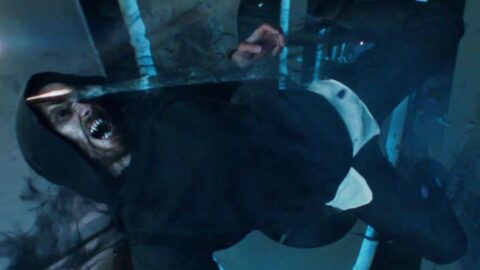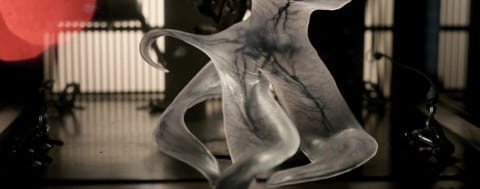Morbius (2022)
Directed by: Daniel Espinosa
Written by: Burk Sharpless, Matt Sazama
Starring: Adria Arjona, Jared Harris, Jared Leto, Matt Smith
USA
IN CINEMAS NOW
RUNNING TIME: 104 mins
REVIEWED BY: Dr Lenera

As a child, Michael Morbius becomes friends with Milo, the two of them struggling with the same rare blood disease which requires constant medical supervision, though they find a father figure in the hospital’s Dr. Nicholas. As an adult, Dr. Morbius is working to find a cure for himself and publicly declines a Nobel Prize for his work with synthetic blood. His colleague Martine Bancroft discovers that he’s secretly captured dozens of vampire bats from Costa Rica in the hope of splicing their genes with his own to cure his condition. But the serum instead manages to transform him into a powerful creature that needs to drink human blood to survive. Morbius fights to contain his evil, working with a synthetic blood he developed, but then Milo, unwilling to listen to his friend’s pleas, also takes the serum….

Morbius passes by in an almost incoherent blur of hazy movement and jumpy plotting, moving extremely fast but rarely engaging. It’s Sony’s third stab at a film set in the world of Spiderman that doesn’t actually Spiderman, following the two Venom pictures, but it feels like a throwback to that small cycle that took place in the mid to late ’50s when traditional monsters were brought back to the screen using science to explain their conditions in the likes of The Werewolf and Teenage Vampire, supposedly bringing the Gothic up to date. It also feels like the most hacked down film in ages; we know of the reshoots which included new footage tie-ing it with Spiderman: No Way Home, some of which was then cut out, but there are snippets of three scenes in the trailer which are not in the finished product, plus seemingly evidence of much slashing elsewhere, with a story that leaves us full of questions and rushes from scene to the next leaving little room for us to care, and all this despite the great Pietro Scalia being credited as editor! It appears that the studio didn’t know what they wanted this film to be, then lost confidence in the final cut and opted to cut it down to the very basics, while seemingly not spending much money on CGI from the looks of things. And then there’s the daft lengths it goes to to not show blood or graphic violence, a serious problem when much of the film features either its good vampire and its bad vampire killing people or said good vampire and bad vampire fighting; these are vampires for god’s sake! Blade this certainly ain’t, even though I got such vibes from the trailer, vibes which were well and truly dashed within a few minutes, even though Morbius was originally going to appear in the first two Blade movies but was cut out of the first one and then not even written into the second.
Strange editing is already on display in the opening section, with us first joining the adult Morbius in Costa Rica to collect vampire bats for experimentation, emerging from a helicopter a weak man barely able to hold himself up with crutches. He enters a fairly impressive looking cave with loads of vampire bats before we cut to the young Morbius at school, as the script rushes through what was probably a considerably longer setup. As a child, Morbius is stuck in a Greek hospital and is initially dismissive of new addition Milo. The latter is actually named Lucien, but he accepts Morbius’s nickname without argument, creating the first of the many questions which are unanswered in the final cut. Morbius is attacked by some other kids, but the boys’ adoptive father and hospital director Nicholas saves him, then has to pull him off one of the bullies when Morbius goes a bit mad with revenge. Nicholas arranges for Michael to attend medical school in New York while he focuses on caring for Milo. Cut to the present, with Morbius being quickly shown as a medical genius focused only on a cure, refusing the Nobel Prize for his work creating synthetic blood, before we cut back to the cave and we ponder on the fact that at least two scenes look they were cut down to the bare minimum and others seem to be missing. We also get little to no time to establish Morbius’s character before he and his assistant Martine are on a ship about to embark on his strange experiment, guarded by mercenaries for some reason who we know will turn on them. The cure works with Morbius being able to walk, but he’s also monstrous and thirsty for blood, making short work of the mercenaries in what should be an orgy of bloodletting, but despite all that slashing and biting we see literally no blood at all except on some black and white photographs of the carnage later.
Once his bloodlust subsides and he regains his senses, a horrified Michael erases all CCTV footage of his experiment before contacting the authorities and jumping overboard. The name of the ship is ‘The Murnau’, obviously a reference to F.W. Murnau, the director of the first surviving vampire movie Nosferatu, so, like the ship in that film, ‘The Murnau’ arrives in port with its entire crew dead and drained of blood. Morbius returns to New York and discovers he now has superhuman strength, speed, reflexes, and echolocation, with his vampire bats treating him as one of their own. He subsists on his synthetic blood until it gradually ceases to satisfy his needs. FBI agents Simon Stroud and Al Rodriguez investigate Michael’s victims and deduce his involvement, then Milo comes back into the picture. He learns that Michael is cured, but becomes furious when Michael refuses to cure him as well. Michael has good intentions for refusing, but Milo is determined to have the serum anyway. Soon we have two vampires loose in the city, but one ain’t really so bad, trying to stop himself killing. Most things can be predicted thereafter, with usage of some extremely generic plot elements, though of course a few things don’t make a whole lot of sense – I guess they may have done originally – and one lazy turn disappointingly lets Morbius off the hook with something rather than us being given some moral ambiguity. The Robert Louis Stevenson theme in The Strange Case Of Dr. Jekyll And Mr Hyde of the possible benefits of unleashing the primitive beast inside us is referenced in one line which made me think that at last there was going to be a modicum of depth, but the main subtext is embracing your identity yet again which has been done to death – though then again nearly everything in this movie has been done to death, it also lacking the panache to provide some freshness, meaning that it’s really a bit dull despite the frequent sound and fury.

The action scenes are shot in that infuriating shaky camera, close-up, flash cut style which means that it’s hard to make out what’s going on. The final duel is almost incoherent. Once again myself and others who actually like to see the things that are happening on the screen in front of us are left wondering what the point is. The favourite device of director Daniel Espinosa and cinematographer Oliver Wood is to hurl us through the air following one of our vampires as they leap around leaving trails of coloured smoke-like stuff for no apparent reason than it was though to look cool, then following it with some slow motion. They do this so often that it becomes tiresome, and there’s rarely any rhythm to what they do throughout, but then the thing is so visually drab too, and lets not forget the weakness of many of the effects, especially the faces of the vampires themselves which really do like they were done in the rush on the cheap; these days there’s no excuse for such shoddy work. In one of my other reviews I’m currently doing I commented on the terrible immobile mask in 1958’s very low budget Monster On The Campus, but quite frankly what we see on display here is little better. At least Jared Leto and Matt Smith both do well, Leto being admirably restrained yet still evoking his character’s torment, leaving Matt Smith to chew the scenery, entirely appropriately seeing as Mill is one of those bloodsuckers who thinks it’s fun to be a vampire. He tends to be given better dialogue, too.
The avoidance of the red stuff perhaps reaches its ridiculous low when a man acts like his throat is cut open but there’s literally nothing there. There’s another scene when somebody else has his stomach slashed badly, but the blood is not red, it’s black, and it’s not as if the scene is taking place in especially dark surroundings either. At least there are a few minor jolts and one genuinely creepy scene in a hospital corridor, but in general Morbius has suffered greatly by being tailored for a ‘PG-13’ rating in the US, and one wonders why this was done; the material is still hardly kid’s stuff, after all, but then one wonders what the studio and/or the makers were doing as their changes were never for the better it seems. The heart of the story is supposed to be the relationship between Morbius and Milo, but it’s given short shrift, with a few minutes of them in hospital before we rejoin them some time later and it seems that we’re supposed to think that they share a great history. Surely we could have at least had a scene of them having a reunion after they were separated for presumably a fair few years, and why is Milo so envious of Michael in the present day? It’s a similar thing with Morbius and Martine, who seem just like co-workers who like each other as no more than colleagues for several scenes, yet all of a sudden they seem to have feelings for each other, and how exactly does her final scene take place? Mind you, one could ask all sorts of other questions that I won’t mention for fear of giving too much away, but if you go and see this mess than ponder upon why, for example, a Nobel Prize winner not under global scrutiny, how the prime suspect in a front-page story with a rising body count is walking about unnoticed just by wearing a hood, why Morbius is attracted by some people’s blood but not others, and – last but not least – the stupid post-credits material.
The material, despite being so cliched, does have potential, but it’s constantly squandered. How much of this we can blame on screenwriters Matt Sasuma and Burt Sharpless is virtually impossible to judge seeing how much the film has been mucked about with, though of course this is only the latest in a quite long line of superhero and superhero-linked movies that studios have meddled with to poor effect. What’s resulted here is mostly so very tired and going through the motions, a sense increased by Jon Ekstrand’s thoroughly bland music score which does virtually nothing and shows that Hans Zimmer’s Batman scores are still unfortunately in the minds of many composers – or rather studio executives. But then, aside from the good work done by its two stars and the occasional frisson, there really is very little to recommend about Morbius – yet perhaps perversely I’ll be still be checking out a director’s cut if one materialises.
Rating: 














Be the first to comment